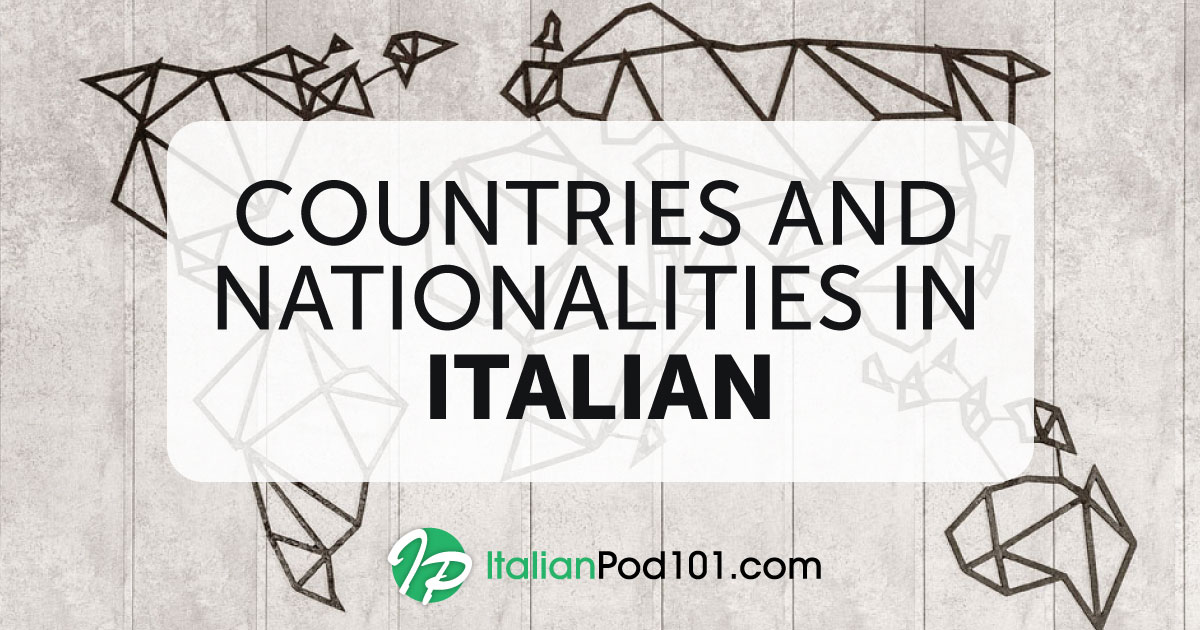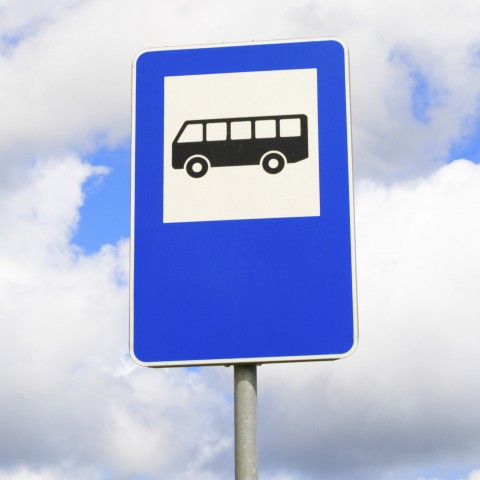
Verbs are concepts in motion and are a fundamental part of every language. But how many Italian language verbs should you learn to speak the language properly? Here at ItalianPod101, we believe that with the following 100+ Italian verbs, you’ll be able to face most circumstances with ease. And don’t be scared—with our examples and definitions, you’ll be able to master this Italian verbs list quickly. It’s Italian verbs made easy with ItalianPod101!
But first, let’s take a look at Italian verb conjugation.
 Table of Contents
Table of Contents
- Italian Regular Verbs
- Italian Irregular Verbs
- Reflexive Verbs in Italian
- Italian Verb Types & Their Meanings
- Italian Verb Placement in a Sentence
- ItalianPod101: A Great Source for Your Italian Learning!
1. Italian Regular Verbs

There are three groups of Italian regular verbs, and their conjugation makes students happy. Indeed, they’re easy to learn and always the same.
The three regular verb groups are:
- Verbs in -are
- Verbs in -ere
- Verbs in -ire
1- Verbs in -are
Here’s a chart with the -are Italian verb conjugation, and an example of how it works with the verb portare, meaning “to bring.”
| 1st sg (I) | 2nd sg (you) | 3rd sg (she) | 1st pl (we) | 2nd pl (you) | 3rd pl (they) |
| Stem + o | Stem + i | Stem + a | Stem + iamo | Stem + ate | Stem + ano |
| Io porto | Tu porti | Egli porta | Noi portiamo | Voi portate | Essi portano |
Some examples of Italian verbs in -are are:
1.
| Amare “to love” | Amo moltissimo viaggiare. “I love traveling very much.” |
2.
| Pensare “to think” | Io lavoro e penso a te. “I work and I think about you.” |
3.
| Cominciare “to start” | Oggi cominciamo un corso di italiano. “Today, we start an Italian course.” |
4.
| Incontrare “to meet” | Il Presidente incontra il suo staff nello Studio Ovale. “The President meets his staff in the Oval Office.” |
2- Verbs in -ere

And now let’s see the conjugation of -ere verbs. We’ll use temere, meaning “to fear,” as an example.
| 1st sg (I) | 2nd sg (you) | 3rd sg (she) | 1st pl (we) | 2nd pl (you) | 3rd pl (they) |
| Stem + o | Stem + i | Stem + e | Stem + iamo | Stem + ete | Stem + ono |
| Io temo | Tu temi | Egli teme | Noi temiamo | Voi temete | Essi temono |
Some examples are:
5.
| Leggere “to read” | Al mattino leggo il giornale. “In the morning, I read the newspaper.” |
6.
| Mettere “to put,” “to wear” | Marco mette sempre lo stesso cappello. “Marco always wears the same hat.” |
7.
| Ridere “to laugh” | Valeria ride sempre, è una ragazza davvero allegra. “Valeria always laughs; she really is a joyful girl.” |
8.
| Prendere “to take,” “to get” | Di solito prendono il caffè in questo bar. “They usually get their coffee in this cafe.” |

3- Verbs in -ire
The -ire verbs in Italian have two conjugations:
- Verbs in -ire (simple)
This is the simplest conjugation. Here, we use the verb partire, meaning “to leave,” as an example.
| 1st sg (I) | 1st sg (I) | 3rd sg (she) | 1st pl (we) | 1st pl (we) | 3rd pl (they) |
| Stem + o | Stem + i | Stem + e | Stem + iamo | Stem + ite | Stem + ono |
| Io parto | Tu parti | Egli parte | Noi partiamo | Voi partite | Essi partono |
Other examples are:
9.
| Aprire “to open” | Il negozio apre dalle ore 10 alle ore 18. “The shop is open from 10 to 18.” |
10.
| Sentire “to hear,” “to feel” | Sento freddo, puoi chiudere la finestra per favore? “I feel cold, can you please close the window?” |
- Verbs in -ire (with -isc-)
This is a slightly more complex conjugation. We’ll use the verb colpire, meaning “to hit,” as an example.
| 1st sg (I) | 2nd sg (you) | 3rd sg (she) | 1st pl (we) | 2nd pl (you) | 3rd pl (they) |
| Stem + isco | Stem + isci | Stem + isce | Stem + iamo | Stem + ite | Stem + iscono |
| Io colpisco | Tu colpisci | Egli colpisce | Noi colpiamo | Voi colpite | Essi colpiscono |
Examples:
11.
| Capire “to understand” | Kate capisce benissimo l’italiano. “Kate understands Italian very well.” |
12.
| Pulire “to clean” | Mia zia pulisce la casa ogni giorno. “My aunt cleans the house every day.” |
2. Italian Irregular Verbs

Unfortunately, many very important Italian verbs are irregular, and this means that you have to learn their conjugation one by one. But don’t worry, with our help you’ll master them like it was the most natural thing in the world.
By far, the most important Italian irregular verbs are essere (“to be”) and avere (“to have”), which also work as Italian auxiliary verbs.
13.
| Essere “to be” | Lorenzo è un bravissimo cuoco. “Lorenzo is a great chef.” |
14.
| Avere “to have” | Luca e Antonia hanno una casa stupenda in Toscana. “Luca and Antonia have a wonderful house in Tuscany.” |
Other important examples of irregular verbs are:
15.
| Andare “to go” | In Italia i bambini vanno a scuola dalle 8 alle 13. “In Italy, children go to school from 8 to 13.” |
16.
| Venire “to come” | Se non è un problema, vengo con voi. “If it’s not a problem, I’ll come with you.” |
17.
| Potere “can,” “may” | Posso raggiungervi più tardi? “May I join you later?” |
18.
| Dovere “to have to” | Devi parlare con tua madre. “You have to talk to your mother.” |
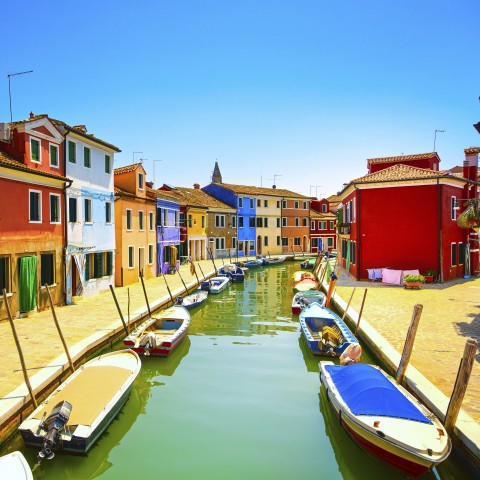
3. Reflexive Verbs in Italian
Reflexive verbs in Italian are very common and can sometimes be hard to understand for students. This is because some of them don’t actually have a real reflexive meaning. In sentences, even those verbs that have an identical subject and object are more like expressions in Italian than actual reflexive verbs as they’re thought of in English.
An example is the verb svegliarsi, which literally means “to wake yourself up.” But it really just means “to wake up.”
Some of the most important reflexive verbs are:
19.
| Divertirsi “to have fun” | Mi sono divertito molto questa sera. “I really had fun tonight.” |
20.
| Lavarsi “to wash up” | Ti sei lavato i denti? “Did you brush your teeth?” (literally, “Did you wash your teeth?”) |
21.
| Alzarsi “to stand up” | Quando l’insegnante entra in classe, dovete alzarvi. “When the teacher comes in the classroom, you have to stand up.” |
22.
| Addormentarsi “to fall asleep” | Ieri mi sono addormentata sul divano. “Yesterday, I fell asleep on the couch.” |
4. Italian Verb Types & Their Meanings

Following are a few lists of the best Italian verbs to know as a beginner in the language. Beginning with Italian action verbs, we’ll go through a variety of verb types that we’ve categorized for your convenience. Let’s get started!
Italian Action Verbs
23.
| Arrivare “to arrive” | I miei cugini sono arrivati ieri sera. “My cousins arrived yesterday evening.” |
24.
| Stare “to stay” | A Parigi starò a casa di un’amica. “In Paris, I’ll stay at a friend’s house.” |
25.
| Fermarsi “to stop” | Fermati qui, c’è un buon ristorante. “Stop here, there’s a good restaurant.” |
26.
| Camminare “to walk” | Amo camminare sulla spiaggia. “I love walking on the beach.” |
27.
| Cercare “to search,” “to look for” | Scusi, cerco un bancomat. Sa dove posso trovarlo? “Excuse me, I’m looking for an ATM. Do you know where I can find it?” |
28.
| Trovare “to find” | Ho trovato un buon amico. “I’ve found a good friend.” |
29.
| Spostare “to move” | Per favore, aiutami a spostare il tavolo. “Please, help me to move the table.” |
30.
| Tirare “to pull” | Tira per aprire. “Pull to open.” |
31.
| Spingere “to push” | Sto scendendo, non serve spingere! “I’m getting off, there’s no need to push!” |
32.
| Correre “to run” | Mia sorella corre ogni mattina per 10 chilometri. “My sister runs for ten kilometers every morning.” |
33.
| Viaggiare “to travel” | Viaggio almeno due volte all’anno. “I travel at least twice a year.” |
34.
| Rimanere “to remain,” “to stay” | Vorrei rimanere di più, ma non posso. “I’d like to stay longer, but I can’t.” |
35.
| Tenere “to keep,” “to hold” | Tienimi la mano. “Hold my hand.” |
36.
| Trasportare “to transport,” “to carry” | Questo camion trasporta frutta. “This truck transports fruit.” |

Mental Verbs
37.
| Volere “to want” | Sono stanca, voglio andare a dormire. “I’m tired, I want to go to bed.” |
38.
| Sapere “to know” | So chi è stato. “I know who did it.” |
39.
| Credere “to believe” | Credo che tu abbia ragione. “I believe you’re right.” |
40.
| Sperare “to hope” | Spero che l’esame vada bene. “I hope the test will go well.” |
41.
| Piacere “to like” | Il caffè italiano mi piace molto. “I like Italian coffee very much.” |
42.
| Dispiacere “to be sorry” | Mi dispiace che tu non ti sia divertito. “I’m sorry that you didn’t have fun.” |
43.
| Ricordare “to remember,” “to remind” | Questa canzone mi ricorda la mia infanzia. “This song reminds me of my childhood.” |
44.
| Dimenticare “to forget” | Ho dimenticato le chiavi. “I forgot the keys.” |
45.
| Imparare “to learn” | Sto imparando l’italiano. “I’m learning Italian.” |
46.
| Sognare “to dream” | Sogno di visitare Venezia. “I dream of visiting Venice.” |
47.
| Desiderare “to wish” | Desidero rivederti. “I wish to see you again.” |
48.
| Odiare “to hate” | Mia figlia odia il cavolfiore. “My daughter hates cauliflower.” |
Verbs of Change
The world is full of change and nothing is to be taken for granted. Here are some useful Italian verbs to learn to talk about change!
49.
| Cambiare “to change” | Il paesaggio è davvero cambiato. “The landscape has really changed.” |
50.
| Diventare “to become” | Crescendo, sono diventata più indipendente. “Growing up, I’ve become more independent.” |
51.
| Migliorare “to improve” | Il mio italiano è migliorato nell’ultimo anno. “My Italian has improved over the last year.” |
52.
| Peggiorare “to worsen” | Il tempo è peggiorato rapidamente. “The weather has quickly worsened.” |
53.
| Aumentare “to increase” | Il mio stipendio è aumentato di 100 euro. “My salary has increased by 100 euro.” |
54.
| Diminuire “to decrease,” “to reduce” | Bisogna diminuire le spese. “We have to reduce our expenses.” |

Verbs for the Workplace
Here are some Italian verbs you must know to talk about work and different types of jobs.
55.
| Lavorare “to work” | Matteo lavora 10 ore al giorno. “Matteo works ten hours a day.” |
56.
| Fare “to make,” “to do” | Faccio spesso degli errori di ortografia. “I often make spelling mistakes.” |
57.
| Finire “to end,” “to finish” | Ho finito il nuovo libro di Elena Ferrante. “I’ve finished Elena Ferrante’s new novel.” |
58.
| Iniziare “to start,” “to begin” | Hai iniziato a fare i compiti? “Did you start doing your homework?” |
59.
| Costruire “to build” | Mio nonno ha costruito questa casa. “My grandfather built this house.” |
60.
| Creare “to create” | Leonardo ha creato un capolavoro. “Leonardo created a masterpiece.” |
61.
| Cucinare “to cook” | Mio padre ha cucinato la pasta. “My father cooked pasta.” |
62.
| Mescolare “to mix” | Mescola il latte con le uova. “Mix the milk with the eggs.” |
63.
| Tagliare “to cut” | Per favore, taglia il pane. “Please, cut the bread.” |
64.
| Servire “to serve” | Servire a temperatura ambiente. “Serve at room temperature.” |
65.
| Guidare “to drive” | Non mi piace guidare molte ore. “I don’t like to drive for many hours.” |
66.
| Usare “to use” | Posso usare la tua auto? “Could I use your car?” |
67.
| Scrivere “to write” | Gli scriverò una lettera. “I’ll write him a letter.” |
68.
| Telefonare “to phone” | Domani telefonerò all’ufficio. “Tomorrow, I’ll phone the office.” |
69.
| Chiamare “to call” | Andrea ti chiamerà più tardi. “Andrea will call you later.” |
70.
| Chiedere “to ask,” “to request” | Marco ha chiesto a Valentina di sposarlo. “Marco asked Valentina to marry him.” |
71.
| Rispondere “to answer” | Ti prego di rispondere al più presto. “Please, answer as soon as possible.” |
72.
| Firmare “to sign” | Ho appena firmato il contratto. “I’ve just signed the contract.” |
Sensory Verbs
73.
| Guardare “to watch” | Sto guardando la tv. “I’m watching TV.” |
74.
| Vedere “to see” | È così buio che non vedo nulla. “It’s so dark that I can’t see anything.” |
75.
| Ascoltare “to listen” | Roberto ascolta solo la musica metal. “Roberto only listens to metal music.” |
76.
| Assaggiare “to taste” | Voglio assaggiare questo vino. “I want to taste this wine.” |
77.
| Profumare “to smell” | La tua macchina profuma di sapone. “Your car smells like soap.” |
78.
| Toccare “to touch” | Tocca questo tessuto: è morbidissimo. “Touch this fabric; it’s really soft.” |
9- Other Italian Verbs for Beginners
79.
| Parlare “to talk,” “to speak” | Io e mia sorella parliamo ogni giorno al telefono. “My sister and I talk everyday on the phone.” |
80.
| Dipingere “to paint” | Michelangelo ha dipinto la Cappella Sistina. “Michelangelo painted the Cappella Sistina.” |
81.
| Suonare “to play (an instrument)” | Maria sa suonare il piano. “Maria can play the piano.” |
82.
| Recitare “to play (like an actor)” | Al Pacino ha recitato ne Il Padrino. “Al Pacino played in The Godfather.” |
83.
| Mangiare “to eat” | Di solito a pranzo mangio un panino. “I usually eat a sandwich for lunch.” |
84.
| Bere “to drink” | Ti andrebbe di bere qualcosa con me? “Would you like to drink something with me?” |
85.
| Dormire “to sleep” | La domenica dormo sempre fino a tardi. “On Sundays, I always sleep until late.” |
86.
| Riposare “to rest” | In vacanza non ho riposato per niente. “On holiday, I couldn’t rest for a moment.” |
87.
| Vestirsi “to get dressed” | Vestiti, dobbiamo uscire. “Get dressed, we have to go out.” |
88.
| Nuotare “to swim” | Non so nuotare. “I can’t swim.” |
89.
| Sdraiarsi “to lie” | Mi sono sdraiato per terra. “I lay down on the ground.” |
90.
| Salire “to get on,” “to get up” | Sono salito sull’ultimo autobus. “I got on the last bus.” |
91.
| Scendere “to get off” | Scusi, devo scendere alla prossima fermata. “Excuse me, I have to get off at the next stop.” |
92.
| Sollevare “to lift” | Questa macchina solleva fino a una tonnellata di peso. “This machine lifts up to one ton of weight.” |
93.
| Passare “to pass” | Passami il sale, per favore. “Pass me the salt, please.” |
94.
| Inventare “to invent” | Marconi ha inventato la radio. “Marconi invented the radio.” |
95.
| Comprare “To buy” | Hai comprato il latte? “Did you buy the milk?” |
96.
| Vendere “to sell” | Il negozio all’angolo vende borse e scarpe. “The shop at the corner sells bags and shoes.” |
97.
| Pagare “to pay” | Ho pagato 10 € per una pizza a una birra. “I paid 10 € for a pizza and a beer.” |
98.
| Vincere “to win” | La Ferrari ha vinto l’ultimo Gran Premio. “The Ferrari won the latest Grand Prix.” |
99.
| Perdere “to lose” | Ho perso il cellulare. “I’ve lost my mobile phone.” |
100.
| Nascere “to be born” | Sono nato in Francia, ma sono cresciuto in Belgio. “I was born in France, but I grew up in Belgium.” |
101.
| Morire “to die” | Nell’incidente per fortuna non è morto nessuno. “Luckily, nobody died in the accident.” |
5. Italian Verb Placement in a Sentence
As you can see from the many sentences above, in Italian, a verb usually goes after the subject and before the object (or any other complement).
Example:
Subject + Verb + Object
Il topo mangia il formaggio.
“The mouse eats the cheese.”
6. ItalianPod101: A Great Source for Your Italian Learning!
We hope you enjoyed learning about Italian verbs with us, and that you picked up a few new vocabulary words you can start using today! It will take lots of studying and practice, but you can memorize every word on this list over time. And once you do, why not start on another Italian basic verbs list on ItalianPod101?
Have you already checked out our majestic 100 adjectives article, our amazing 100 nouns list, or our guide on Italian pronouns? If not, it’s time to do it! Improve your Italian with our wonderful guides and lessons, whenever and wherever you want. Download our mobile apps or follow our courses on your PC, and you’ll live the Dolce vita!
Before you go, let us know in the comments if there are any Italian verbs you still want to know! We look forward to hearing from you, and will do our best to help!

Italian Pronouns: Definition, List, and Examples of Use

Pronouns are one of the fundamental bricks in the majestic building of grammar. Basically, what they do is replace another word, allowing us to avoid repetition and making every language more agile, pleasant, and poetic. Italian pronouns are no exception.
A pronoun in Italian can replace:
There are many kinds of Italian pronouns, categorized by their function in a sentence. In this Italian pronouns lesson here on ItalianPod101.com, we’ll show you a list of all the most important ones, with their definitions and examples of Italian pronoun usage. It’s Italian pronouns, made easy!
 Table of Contents
Table of Contents
- Italian personal pronouns
- Italian possessive pronouns
- Italian reflexive pronouns
- Italian demonstrative pronouns
- Italian interrogative and exclamatory pronouns
- Italian indefinite pronouns
- Italian relative pronouns
- ItalianPod101: Fast & Fun Italian for All
1- Italian personal pronouns

A personal pronoun is a word that indicates who or what is involved in a sentence, without having to repeat it in full. Let’s clarify with an example in English: “My daughter is on holiday. She’s very happy.” Without pronouns, we would say: “My daughter is on holiday. My daughter is very happy.” A bit annoying, isn’t it?
Now, there are two categories of Italian personal pronouns:
- Subject pronouns: When the replaced element is the subject of the sentence.
- Object pronouns: When the replaced element is the object of the sentence.
Further, there are two kinds of object pronouns.
- Direct object pronouns: When the pronoun replaces a direct object, answering the question “Who?” or “What?”
- Indirect object pronouns: When the pronoun replaces an indirect object, answering the question “To whom?” or “To what?”
Now, let’s see them in action in this nice and neat Italian pronouns table.
| Italian subject pronouns | Italian direct object pronouns | Italian indirect object pronouns | |
|---|---|---|---|
| 1st person singular | Io (“I”) | Mi (“Me”) | Mi (“To me”) |
| 2nd person singular | Tu (“You”) | Ti (“You”) | Ti (“To you”) |
| 3rd person singular | Informal: Lui, Lei (“He, She”). Formal: Egli, Ella, Esso, Essa (“He, She, It male, It female”) * | Lo (“Him, It male”), La (“Her, It female”), L’ (“Him, Her, It” whenever the following word begins with a vowel) | Gli (“To him, her, it”) |
| 1st person plural | Noi (“We”) | Ci (“Us”) | Ci (“To us”) |
| 2nd person plural | Voi (“You”) | Vi (“You”) | Vi (“To you”) |
| 3rd person plural | Informal: Loro (“They”). Formal: Essi, Esse (“They,” male and female) * | Li, Le (“Them,” male and female) | Gli, Loro (“To them”) |
| *Used in written, formal language, like in literature or official documents. | |||
And now, let’s dive into these Italian pronouns with examples!
Italian subject pronouns:
- Io
- Io vado al cinema, vuoi venire?
“I’m going to the cinema, do you want to come?”
- Tu
- Tu puoi andare ora.
“You can go now.”
- Lui
- Lui aveva fame ed è tornato a casa.
“He was hungry and has gone home.”
- Lei
- Lei, Marta, è davvero una persona interessante.
“She, Marta, really is an interesting person.”
- Noi
- Noi andremo in vacanza fra una settimana.
“We’ll go on holiday in one week.”
- Voi
- Voi avete guardato la partita ieri?
“Did you watch the match yesterday?”
- Loro
- Loro non sono qui perché non sono stati invitati.
“They are not here because they were not invited.”
Direct object pronouns:
- Mi
- Ieri Marco mi ha visto ma non mi ha salutato.
“Yesterday, Marco saw me but he didn’t say hello to me.”
- Ti
- Ti chiamerò domani per confermare l’accordo.
“I’ll call you tomorrow to confirm the deal.”
- Lo
- Cerco Giuliano, lo hai visto?
- “I’m looking for Giuliano, have you seen him?”
- La
- Ti piace la pasta? Io la adoro.
“Do you like pasta? I love it.”
- L’
- Il Barolo è buonissimo, l’ho assaggiato in Piemonte.
“Barolo is very good, I’ve tasted it in Piedmont.”
- Ci
- Lorenzo ci ha invitati al suo matrimonio.
“Lorenzo has invited us to his wedding.”
- Vi
- Martedì vi porto a cena in un ristorante buonissimo.
“Tuesday, I’ll bring you to dinner in a very good restaurant.”
- Li
- Li ho incontrati stamattina al supermercato.
“I bumped into them this morning at the supermarket.”
- Le
- A: Hai tu le mie scarpe bianche?
B: No, non le ho io.
A: “Do you have my white shoes?”
B: “No, I don’t have them.”
Indirect object pronouns:
- Mi
- Ieri Andrea mi ha dato una bellissima lettera.
“Yesterday, Andrea gave me a beautiful letter.”
- Ti
- Ho bisogno di parlarti.
“I need to talk to you.”
- Gli
- Gli ho consigliato di accettare il lavoro.
“I’ve suggested to him to accept the job.”
- Ci
- Roma ci piace così tanto che abbiamo deciso di vivere lì.
“We like Rome so much that we’ve decided to live there.”
- Vi
- Più tardi vi mando un’e-mail con i dettagli.
“Later, I’ll send you an email with the details.”
- Gli / Loro
- Gli ho detto che devono partire entro domani. / Ho detto loro che devono partire entro domani.
“I’ve told them that they must leave by tomorrow.”
Two important notes:
- Unlike in other languages, in Italian, the use of the subject pronoun in a sentence isn’t mandatory. In fact, the subject pronoun is usually omitted, except when it’s needed to avoid ambiguity.
- Sono andato a letto presto, perché ero stanco.
“(I) went to bed early, because (I) was tired.”
- In some cases, when you use an infinitive verb, you can add the object pronouns at the end of the sentence, attaching it to the infinitive verb.
- Vieni a trovarci questa estate?
“Are you coming to visit us this summer?”

2- Italian possessive pronouns
Italian possessive pronouns are identical to possessive adjectives. They replace the possessed object and must always be preceded by a definite article or a preposition + definite article. They’re conjugated according to gender and number.
They are:
- Mio / mia / miei / mie
- Adoro il tuo stereo. Il mio è vecchio.
“I love your stereo. Mine is old.”
- Tuo / tua / tuoi / tue
- Le mie nuove scarpe da trekking sono perfette. Come vanno le tue?
“My new trekking shoes are perfect. How are yours going?”
- Suo / sua / suoi / sue
- La mia valigia è stata finalmente trovata, ma della sua ancora non si sa nulla.
“My luggage was finally found, but we still don’t know anything about his.”
- Nostro / nostra / nostri / nostre
- Tuo figlio adora il basket, mentre i nostri preferiscono il calcio.
“Your son loves basketball, while ours prefers football.”
- Vostro / vostra / vostri / vostre
- Il mio cane è un pastore tedesco, e il vostro?
“My dog is a German shepherd, and yours?”
- Loro
- Il mio lavoro mi lascia molto tempo libero, mentre il loro no.
“My job gives me a lot of free time, while theirs does not.”

3- Italian reflexive pronouns
Reflexive pronouns are used when the subject of a sentence is also the object. There are a lot of very common reflexive verbs in Italian, and they can be a bit confusing. Anyway, the Italian reflexive pronouns are:
- Mi (“Myself”)
- Mi sto facendo la doccia.
“I’m taking a shower.”
- Ti (“Yourself”)
- Ti sei lavato le mani?
“Did you wash your hands?”
- Si (“Himself, Herself, Themselves”)
- Si è vestito in fretta ed è uscito.
“He dressed up quickly and got out.”
- Ci (“Ourself”)
- Io e Antonio ci amiamo molto.
“Antonio and I love each other very much.”
- Vi (“Yourself”, plural)
- Oggi vi siete svegliate molto presto, come mai?
“Today you got up very early, why?”
4- Italian demonstrative pronouns
Demonstrative pronouns are used instead of a noun to point out a specific person or thing. The most common Italian demonstrative pronouns are:
- Questo / questa / questi / queste (“This, these”)
- Questo è Luca, mio marito.
“This is Luca, my husband.”
- Quello / quella / quelli / quelle (“That, those”)
- Quelli che vedete sono i resti di un grande tempio romano.
“Those you see are the remains of a big Roman temple.”
5- Italian interrogative and exclamatory pronouns

Interrogative and exclamatory pronouns are used to form questions or exclamations. In Italian, they are:
- Chi (“Who”)
- Chi è l’uomo con cui parla Simone?
“Who is the man Simone is talking to?”
- Che cosa / Cosa / Che (“What”). All of these options are synonyms.
- Cos’è successo?
“What happened?”
- Quanto / quanta / quanti / quante (“How much” but also “So much” in exclamations)
- Quanto mi manchi!
“I miss you so much!”
- Quale / quali (“Which one”)
- Tra pizza e pasta, quale preferisci?
“Between pizza and pasta, which one do you prefer?”

6- Italian indefinite pronouns
Indefinite pronouns are used to indicate something or someone in general. The most common Italian indefinite pronouns are:
- Alcuno / alcuna / alcuni / alcune (“Some”)
- A: Ti sono piaciute le opere in mostra?
B: Alcune mi sono piaciute, ma non tutte.
A: “Did you like the artworks on display?”
B: “Some I liked, but not all of them.”
- Molto / molta / molti / molte (“Many, a lot”)
- A: Hai fame?
B: Molta!
A: “Are you hungry?”
B: “A lot!”
- Poco / poca / pochi / poche (“Few”)
- A: C’era molta gente al concerto?
B: No, poca.
A: “Were there many people at the concert?”
B: “No, not much.”
- Tanto / tanta / tanti / tante (“Many”)
- Tanti sono venuti alla manifestazione, nonostante il freddo.
“Many went to the demonstration, despite the cold.”
- Troppo / troppa / troppi / troppe (“Too much, too many”)
- Troppi non sono tornati dalla guerra.
“Too many didn’t come back from the war.”
- Tutto / tutta / tutti / tutte (“All, everyone”)
- Siamo arrivati tutti in ritardo.
“We’ve all arrived late.”
- Uno / una (“One”)
- A: Hai un cellulare?
B: Ne ho uno, ma è vecchio.
A: “Do you have a mobile phone?”
B: “I have one, but it’s old.”
- Qualcuno / qualcuna (“Someone, anyone”)
- Qualcuno sa dirmi dov’è Dario?
“Could anyone tell me where Dario is?”
- Ciascuno / ciascuna (“Everyone, each one”)
- Ciascuno di noi ha un compito.
“Each one of us has a task.”
- Ognuno / ognuna (“Everyone, each one”)
- Ognuno deve fare la sua parte.
“Everyone has to do their part.”
- Nessuno / nessuna (“No one, any”)
- Nessuno sa perché è successo.
“No one knows why it happened.”
- Sono andata a cercare funghi nel bosco, ma non ne ho trovato nessuno.
“I went looking for mushrooms in the forest, but I didn’t find any.”

7- Italian relative pronouns
Relative pronouns connect a sentence with a subordinate clause. The Italian relative pronouns are:
- Che (replaces a subject or direct object)
- La donna che sta parlando con Leo è il mio capo.
“The woman who is talking with Leo is my boss.”
- Chi (“The person who, the people who, whoever”)
- Chi è stato?
“Who did it?”
- Cui (replaces an indirect object)
- La ragazza di cui ti ho parlato sta entrando nella stanza proprio adesso.
“The girl I told you about is entering the room right now.”
- Il quale / la quale / i quali / le quali (same as Cui)
- La persona per la quale lavoro si chiama Mario Rossi.
“The person I work for is called Mario Rossi.”
8. ItalianPod101: Fast & Fun Italian for All
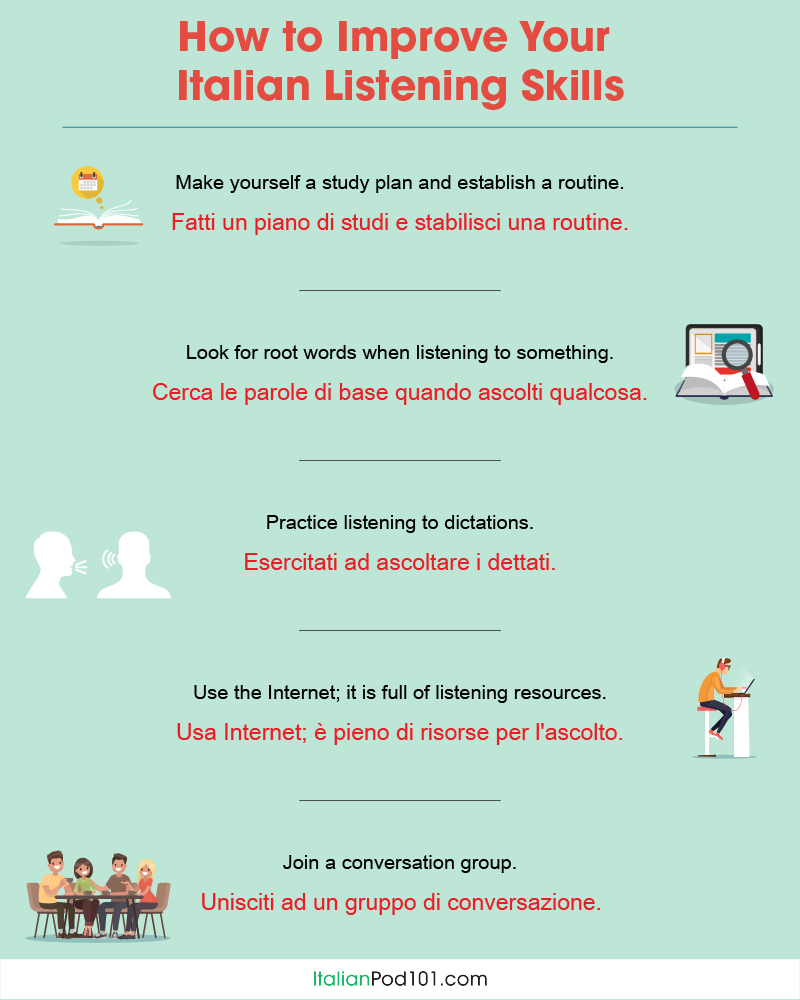
Mastering Italian pronouns is no easy feat, but with enough practice, you’ll get there! We hope you enjoyed this article and that you’re well on your way to really understanding Italian pronouns.
If there’s anything you didn’t quite understand, don’t hesitate to reach out in the comments. We’ll do our best to help you out!
Grammar is a complicated universe, but we at ItalianPod101 are here to help! Check out our lesson library and enjoy hours of videos, tons of useful articles, and practical mobile tools to learn and study whenever and wherever you want.
Happy Italian learning!

Italian Word Order: From Basic to Complex Sentences

When speaking a new language, you’ll find that many things about it are different compared to the language you’re used to. Sounds, words, grammar, everything is…foreign? Well, yes, of course.
But maybe you haven’t yet thought about whether or not the sentence structure and word order are different, too.
First of all, what do we mean by that? We’re talking about the basic word order, the correct sequence of all the elements that form the basic structure of a sentence.
If you compare the English and Italian sentence structure, you’ll definitely find differences that might create some confusion, especially when you get to negative sentences, questions, and complex phrases. But don’t worry about it; we’re here to help you with this simple guide. We’ll help you understand the basics of Italian word order rules, and then we’ll guide you until you’re able to perform well when creating more advanced sentences.
So, are you ready to learn about word order in Italian?
 Table of Contents
Table of Contents
- The Basics of Italian Word Order with Subject, Verb, and Object
- Il Buono, il Brutto e il Cattivo: Italian Word Order with Modifiers
- The Importance of Exercising
- The Famous Last Words
1. The Basics of Italian Word Order with Subject, Verb, and Object
The basic Italian sentence structure, as with all Neo-Latin languages, follows the Subject – Verb – Object (SVO) pattern.
(And by the way, since we’ll be talking a lot about apples…what about checking out how to say the names of all kinds of fruit?)
First of all, let’s see what the single elements of this sentence mean:
- {Eva mangia una mela.} (“Eva eats an apple.”)
Subject = It’s who/what is doing the action >> Eva mangia una mela.
Verb = It’s the action >> Eva mangia una mela.
Object = It’s the destination of the action >> Eva mangia una mela.
The sentence structure doesn’t change, even if you want to make the same sentence interrogative. In fact, in Italian, there is no S-V inversion as there is in other European languages (French and German, for example), and you don’t need to add anything to the sentence as you would do in English.
In the case of Italian question word order, the basic sentence structure remains the same; you just need to add the interrogative tone and the question mark.

Eva, are you really going to eat that…???
See the examples:
- {Eva mangia una mela.} (“Eva eats an apple.”)
- {Eva mangia una mela?} (“Does Eva eat an apple?”)
- {Studi l’italiano.} (“You study Italian.”)
- {Studi l’italiano?} (“Do you study Italian?”)
Notice how in Italian, we generally omit the personal pronoun as a subject (io, tu, lui/lei, noi, voi, loro – “I, you, he/she, we, you, they”) unless there’s an ambiguity in the sentence, or you want to give particular emphasis to the person doing the action.
But what happens when you want to make a negative sentence? Very simple. You add the negative adverb non in front of the verb:
- {Eva non mangia una mela.} (“Eva does not eat an apple.”)
- {Eva non mangia una mela?} (“Doesn’t Eva eat an apple?”)
- {Non studi l’italiano.} (“You don’t study Italian.”)
- {Non studi l’italiano?} (“Don’t you study Italian?”)
As you can see, whether it’s affirmative or interrogative doesn’t change the structure of the sentence.
This is always the basic structure, even when the sentence becomes more complicated. For example, you could have a whole clause as a subject:
La prima donna che abita sulla terra mangia la mela. (“The first woman living on earth eats the apple.”)
Similarly, you could have a whole clause as an object:
Eva mangia quel frutto rosso o giallo o verde che chiamiamo mela. (“Eva eats that red or yellow or green fruit that we call apple.”)
2. Il Buono, il Brutto e il Cattivo: Italian Word Order with Modifiers

Let’s look at the word order in Italian sentences when things get more complex. What happens to the sentence when you add, for example, an adjective that modifies the nouns (like bravo or “good”), or an adverb that modifies the verb (like sempre or “always”). These are called modifiers, as they’re used to add meaning—and therefore modify—the element they go with.
1. Adjectives
- {Lo studente studia l’italiano.} (“The student studies Italian.”)
What if I want to add that we’re talking about an “American” student (americano) studying Italian?
- {Lo studente americano studia l’italiano.} (“The American student studies Italian.”)
Did you see what happened? The adjective went after the noun. And this is the general rule: Italian adjectives follow the noun:
L’italiano non è una lingua (noun) difficile (adjective). (“Italian is not a difficult language.”)
Ho comprato un vestito rosso. (“I bought a red dress.”)
Sei un ragazzo simpatico! (“You are a nice boy!”)
But all rules have an exception, right? So, keep in mind that some of the most common Italian adjectives are placed before the noun. And here’s the list:
| bello | “beautiful” | Un bel* ragazzo | “A beautiful boy” |
| bravo | “good” | Una brava ragazza | “A good girl” |
| brutto | “ugly,” “bad” | È un brutto giorno | “It’s a bad day” |
| buono | “good” | Hai fatto un buon* lavoro. | “You did a good job.” |
| caro | “dear” | Sono dei cari amici. | “They are dear friends.” |
| cattivo | “bad” | Non dare il cattivo esempio. | “Don’t set a bad example.” |
| giovane | “young” | Conosco un giovane attore. | “I know a young actor.” |
| grande | “big” | Abbiamo una grande opportunità. | “We have a great opportunity.” |
| lungo | “long” | Facciamo una lunga passeggiata. | “Let’s take a long walk.” |
| nuovo | “new” | Il nuovo libro è rosso. | “The new book is red.” |
| piccolo | “small,” “little” | Ho un piccolo problema. | “I have a small problem.” |
| stesso | “same” | La stessa ragione | “The same reason” |
| vecchio | “old” | Un vecchio albero | “An old tree” |
| vero | “true” | È una vera avventura! | “It’s a real adventure!” |
*Bello/a and buono/a (“beautiful” and “good”), when they come before a noun, change their endings following the same rules of the definite article (bello >> il) and the indefinite article (buono >> un). Check the following examples. Do you want to know more and practice?

Un bel bambino/Un bambino bello! (“A cute baby!”)
- Il ragazzo >> il bel ragazzo
- Lo studente >> il bello studente
- Un giorno >> un buon giorno
- Uno studente >> un buono studente
But watch out! If they’re used together with an adverb, they must follow the noun, as in the general rule:
- È un vecchio albero. (“It is an old tree.”) | È un albero molto vecchio. (“It is a very old tree.”)
- È un brutto giorno. (“It’s a bad day.”) | È un giorno veramente brutto . (“It’s a really bad day.”)
The same thing happens if you want to convey emphasis or express a contrast. In the following sentence, for example, the stress of the sentence is on the age of the tree, and not the tree itself:
- Questo non è un albero vecchio, è un albero giovane! (“This is not an old tree, it is a new tree!”)
2. Adverbs
Just like adjectives, adverbs are modifiers and they appear in a sentence to slightly modify the meaning of the verb or adjective they go with. In Italian, they’re usually placed after the verb:
- Leggo sempre il giornale. (“I always read the newspaper.”)
- John parla bene l’italiano. (“John speaks Italian well.”)
Naturally, there are some exceptions to this rule in case of:
- Modifying an adjective
- È un albero molto vecchio. (“It is a very old tree.”)
- È un albero molto vecchio. (“It is a very old tree.”)
- Modifying another adverb
- John parla molto bene l’italiano. (“John speaks Italian very well.“)
- John parla molto bene l’italiano. (“John speaks Italian very well.“)
- The negative non, which we’ve already seen
- Non leggo il giornale. (“I don’t read the newspaper.”)
But notice what happens if you add another negative adverb. Let’s compare English to Italian: Double negatives are grammatically incorrect in English, but in the Italian language, they’re perfectly acceptable:
- Non leggo mai il giornale. (“I never read the newspaper.”)
- Non leggo più il giornale. (“I no longer read the newspaper.”)
- Non leggo quasi mai il giornale. (“I almost never read the newspaper.”)
Do you think we can add some more elements to complicate the structure a bit? Certamente! (“Of course!”) Which brings us to the other exception, when an adverb is formed with the -mente suffix (usually equivalent to the English “-ly” suffix).

I always read the newspaper. Do you?
See, for example, the case of normalmente (“generally, normally”):
- A) Normalmente non leggo il giornale.
- B) Non leggo normalmente il giornale.
- C) Non leggo il giornale normalmente.
All these sentences have the same meaning (“I don’t normally read the newspaper”), although we can argue that by moving around the adverb, we end up stressing different parts of the sentence. In A), the stress is on the frequency; in B), it’s on the act of reading; in C), it’s on the newspaper. It’s a small nuance, but nevertheless is there.
3. Adverbs & Auxiliary or Modal Verbs
So far, we’ve looked at simple verbs. But what happens if a verb is composed of an auxiliary, as in the case of the passato prossimo, or with modal verbs (potere, volere, sapere, dovere – “can, will, know, must”)?
With these verbs, you normally follow the general rule. But in the presence of the following adverbs expressing time, assessment, certainty, or doubt, they can be placed in the middle, between the auxiliary and the past participle (or between the modal verb and the infinitive).
| Ancora (“Yet”) | Proprio (“Really”) |
| Appena (“Just”) | Subito (“Immediately”) |
| Finalmente (“Finally”) | Certamente (“Surely”) |
| Già (“Already”) | Forse (“Maybe”) |
| Mai (“Never”) | Nemmeno (“Not even”) |
| Sempre (“Always”) | Probabilmente (“Probably”) |
| Spesso (“Often”) | Sicuramente (“Definitely”) |
- Eva ha appena mangiato la mela… (“Eva just ate the apple…”)
- Non ho ancora letto il giornale. (“I haven’t read the newspaper yet.”)
- Voglio sicuramente studiare l’italiano con ItalianPod101. (“I definitely want to study Italian with ItalianPod101.”)
- Devo proprio chiedere scusa…? (“Do I really have to apologize…?”)
4. Prepositional Phrases
In most sentences, we end up referring to “when,” “where,” and “how” the action is taking (or took) place. These sentences are the ones that explain the when, where, and how, and they’re called prepositional phrases since they’re often introduced by a preposition.
- Studio l’italiano di sera. [when?] (“I study Italian in the evening.”)
- Studio l’italiano a Firenze. [where?] (“I study Italian in Florence.”)
- Studio l’italiano con ItalianPod101. [how?] (“I study Italian with ItalianPod101.”)
As you can see in the examples above, these phrases normally go at the end of the sentence, although with most of the phrases indicating the time aspect of the action (when?), you can safely move the elements around, just as you would in English:
- Studio l’italiano di sera. [when?] (“I study Italian in the evening.”)
- Di sera studio l’italiano. [when?] (“In the evening, I study Italian.”)
- A pranzo non bevo mai il caffè. [when?] (“For lunch, I never have coffee.”)
- Non bevo mai il caffè a pranzo. [when?] (“I never have coffee for lunch.”)
But, if you’re not sure, always place them at the end of the sentence, and you’ll definitely be correct.
If you want more information on Italian prepositions, be sure to take a couple of minutes to watch the video below:
5. Personal Pronouns
Remember the first sentences we looked at?
- {Eva mangia una mela.} (“Eva eats an apple.”)
- {Studi l’italiano.} (“You study Italian.”)
Subject, verb, object. In that order. Well…not always. If you substitute the object with a personal pronoun, that pronoun would still be the object of the action, but it goes BEFORE the verb. Take a look:
- {Eva la mangia in fretta.} (“Eva eats it in a hurry.”)
- {Lo studi con ItalianPod101.} (“You study it with ItalianPod101.”)

Help! I need a Personal [pronoun] Trainer!!!
The same rules apply to indirect personal pronouns, as in:
- Gli chiedo un favore. (“I ask a favor of him.”)
- Mi piace la pizza. (“Pizza pleases me.“= “I like pizza.”)
This is also true for the little pronouns ci (“in it,” “there”) and ne (“of it”).
- A Roma? Ci andiamo domani. (“To Rome? We go there tomorrow.”)
- Ha del prosciutto? Ne vorrei 100 grammi. (“Do you have ham? I would like 100 grams of it.”)
Things, however, change a little when we have these same pronouns, but the verb is an infinitive, a gerund, or an imperative. (Maybe you need a little more practice with those tenses or how they’re conjugated?
Because with these tenses, the pronoun can be placed either before or after. And in case it’s after, you need to attach it to the verb. Let’s see how:
- {Eva mangia una mela.} (“Eva eats an apple.”)
- {Eva la mangia in fretta.} (“Eva eats it in a hurry.”)
- {“Eva, mangiala!} (“Eva, eat it!”)
- {Studi l’italiano.} (“You study Italian.”)
- {Lo studi con ItalianPod101.} (“You study it with ItalianPod101.”)
- {Puoi studiarlo con ItalianPod101.} (“You can study it with ItalianPod101.”)

A little patience and lots of exercise: the perfect strategy for learning a language!
3. The Importance of Exercising
Time to put everything into practice with these step-by-step exercises on Italian word order. Let’s start with a very basic sentence, and we’ll add up elements of complexity. Check the sections above in case you’re uncertain of something.
How would you translate these sentences?
- “Mary studies Italian.” – ________________________________________________________
- “She studies it with ItalianPod101.” – _____________________________________________
- “She studies Italian with ItalianPod101 everyday.” – __________________________________
- “Her friends don’t study Italian with ItalianPod101 yet.” – ______________________________
- “She studies Italian with ItalianPod101 everyday comfortably at home.” – _________________
- “Maria never forgets her Italian lessons.” – _________________________________________
- “Maria has probably studied Italian today.” – _____________________________________
- “This summer, Maria can study it in Florence.” – ______________________________________
Check your answers here:
1. Maria studia l’italiano.
2. Lo studia con ItalianPod101.com.
3. Studia l’italiano con ItalianPod101 ogni giorno.
4. I suoi amici non studiano ancora l’italiano con ItalianPod101.
5. Studia l’italiano con ItalianPod101 ogni giorno comodamente a casa.
6. Maria non dimentica mai le sue lezioni di italiano.
7. Maria ha probabilmente studiato l’Italiano oggi.
8. Quest’estate Maria può studiarlo a Firenze.

4. The Famous Last Words
Now you’ve learned how to structure a sentence in Italian. Soon, with a little practice, you’ll be able to build more and more complex sentences, putting every word in the correct order. Hopefully, this guide has helped you with this mission.
Practice is always the best strategy for improving Italian grammar, vocabulary, and communication skills. So make sure you visit ItalianPod101.com. Here you’ll find a great number of free resources, podcasts, lessons, and even mobile apps and a free PDF with practical and efficient lessons. Keep up with your good work on your Italian learning!
In the meantime, if there’s anything in this lesson you didn’t quite understand, feel free to leave us a comment and we’ll do our best to help you out!

Wait a Minute… Do You Know How to Tell Time in Italian?

How often do you need to check the time every day? Telling the time is part of everyday life, so if you’re making plans for a specific time and date while traveling or studying in Italy, it’s essential that you master this conversation skill as soon as possible.
In this article, I’ll be going over everything from how to say “hour” in Italian to asking for the time and making plans in Italian. Let’s get started.
Che ore sono? è ora di iniziare a divertirsi con ItalianPod101.com! (“What time is it? It’s time to start having fun with ItalianPod101.com!”)
 Table of Contents
Table of Contents
- How to Ask for the Time in Italian
- Italian Hours
- Give Me a Minute…
- How to Divide Hours into Minutes in Italian
- General Time References of the Day in Italian
- Top Italian Time Adverbs
- Italian Proverbs and Sayings about Time
- Conclusion
1. How to Ask for the Time in Italian

To start, let’s see the very first basic phrases you can use to ask for and say the time in Italian:
- Che ore sono? / Che ora è?
These literally translate to “What hours are they?” and “What hour it is?” respectively. They both mean “What time is it?”
This is the easiest way to ask the time in Italian. With this phrase, you don’t have to worry too much about using formal vs. informal speech, as adding scusi (“excuse me” – formal) or scusa (“excuse me” – informal) at the beginning of the sentence can make it more formal or informal.
- Potrebbe/Potresti dirmi l’ora?
This translates to “Could you (formal/informal) tell me the time?”
This is a more complex form of asking for the time in Italian. It can be used both formally and informally as long as you change the person (2nd vs. 3rd) of the subject accordingly.
- A che ora è…? /A che ora comincia…?
These translate to “At what time is…” and “At what time starts …?” respectively. This is the Italian formula for asking when something (a meeting, a show, etc.) is going to start.
Did you notice that in Italian we say ore, literally meaning “hours,” when we talk about time? If you look up ora (“hour” in the singular) in an Italian dictionary, you’ll find that it means both “hour” and “now.” While the literal translation of “time” is tempo, in Italian, we use this word just in the sense of the concept of time—never to represent the passing of time on a clock. Interesting, right?
Che ore sono? Uffa*… il tempo non passa mai… (“What time is it? Geez…time never passes…”)
*Uffa is an untranslatable word that makes life so much more interesting! Depending on the context, it can be translated as “geez/gosh!”, “damn” (angry), “come on!” (impatient), “phew” (generic), or “oh, hum” (bored).
2. Italian Hours
When you say the time in Italian, it’s more common to use the twelve-hour clock, unless it’s in written official communication. In order to avoid confusion or ambiguity, you’ll often hear Italians say the time with the twelve-hour clock, adding di mattina, del pomeriggio, di sera, or di notte (“in the morning, in the afternoon, in the evening, at night”).

Una vecchia clessidra (“An old hourglass”)
There’s no equivalent for “o’clock” in Italian. You simply say the time, and if you want to be very precise, you add in punto. You’ll only use this if you want to remark that it just turned exactly that time: Ci vediamo alle tre in punto! (“We meet at three o’clock (sharp)!”).
To state what time it is, you use the verb essere (“to be”), in the singular è, for midnight (mezzanotte), midday (mezzogiorno), and one o’clock (l’una). The rest of the time, you use the plural sono and the number equivalent to the hour.
But if you want to say what time something happens, you use a/alle and the time, like this: a mezzanotte (“At midnight”), alle tre (“at three”). Remember that alle = a + le. Do you need to brush up on compound prepositions? Follow me!
| È mezzanotte / A mezzanotte | “It’s midnight” / “At midnight” |
| È l’una (di notte) / All’una (di notte) | “It’s one AM” / “At one AM” |
| Sono le due (di notte) / Allle due (di notte) | “It’s two AM” / “At two AM” |
| Sono le tre (di notte) / Alle tre (di notte) | “It’s three AM” / “At three AM” |
| Sono le quattro (di notte) / Alle quattro (di notte) | “It’s four AM” / “At four AM” |
| Sono le cinque (di mattina) / Alle cinque (di mattina) | “It’s five AM” / “At five AM” |
| Sono le sei (di mattina) / Alle sei (di mattina) | “It’s six AM” / “At six AM” |
| Sono le sette (di mattina) / Alle sette (di mattina) | “It’s seven AM” / “At seven AM” |
| Sono le otto (di mattina) / Alle otto (di mattina) | “It’s eight AM” / “At eight AM” |
| Sono le nove (di mattina) / Alle nove (di mattina) | “It’s nine AM” / “At nine AM” |
| Sono le dieci (di mattina) / Alle dieci (di mattina) | “It’s ten AM” / “At ten AM”` |
| Sono le undici (di mattina) / Alle undici (di mattina) | “It’s eleven AM” / “At eleven AM” |
| È mezzogiorno / A mezzogiorno | “It’s noon” / “At noon” |
| È l’una / All’una | “It’s one PM” / “At one PM” |
| Sono le due (di pomeriggio) / Alle due (di pomeriggio) | “It’s two PM” / “At two PM” |
| Sono le tre (di pomeriggio) / Alle tre (di pomeriggio) | “It’s three PM” / “At three PM” |
| Sono le quattro (di pomeriggio) / Alle quattro (di pomeriggio) | “It’s four PM” / “At four PM” |
| Sono le cinque (di pomeriggio) / Alle cinque (di pomeriggio) | “It’s five PM” / “At five PM” |
| Sono le sei (di pomeriggio) / Alle sei (di pomeriggio) | “It’s six PM” / “At six PM” |
| Sono le sette (di sera) / Alle sette (di sera) | “It’s seven PM” / “At seven PM” |
| Sono le otto (di sera) / Alle otto (di sera) | “It’s eight PM” / “At eight PM” |
| Sono le nove (di sera) / Alle nove (di sera) | “It’s nine PM” / “At nine PM” |
| Sono le dieci (di sera) / Alle dieci (di sera) | “It’s ten PM” / “At ten PM” |
| Sono le undici (di sera) / Alle undici (di sera) | “It’s eleven PM” / “At eleven PM” |
Naturally, it’s another matter to know how to write the time in Italian…. Here’s a hint: right now, it’s 11:33.

È ora di pranzo! (“It’s lunchtime!”)
You’ll often find Italians referring to noon or one PM as l’ora di pranzo, meaning “lunchtime.” When it’s time to eat, it’s a sacred time for Italians. So, just a word of advice: avoid planning a meeting around that time unless you’re making plans for a lunch or dinner. Also, remember that the typical time for meals changes according to the region in Italy. Generally, people in the north have lunch around noon, while the more south you go, the later lunchtime (or dinnertime) is, especially in the summer.
3. Give Me a Minute…

A minute isn’t much, but we use the word all the time, both as a reference to sixty seconds and a more generic “little time.”
Kids will always tell you un minuto… cinque minuti… (“one minute… five minutes… “) when you ask them to get out of bed or clean their room, don’t they?
- Sono le otto, alzati! “It’s eight o’clock, get up!”
- Ho sonno… ancora cinque minuti… “I’m sleepy…five more minutes….”
It’s also the typical excuse for the chronic latecomer…
- Ciao, sei pronto? “Hello, are you ready?”
- Ehm…. Quasi… cinque minuti e arrivo… “Ehm…almost…five minutes and I’ll be there…”
Here are a few more useful formulas. Notice how the verb is in the imperative mood. You can practice with these phrases:
Dammi un minuto… “Give me a minute…”
Aspetta un minuto… “Wait a minute…”
The same formulas can be used with secondo, meaning “second.”
But in fact, apart from when we talk about cinque minuti or dieci minuti (“five minutes” or “ten minutes”), we rarely use the word “minute” in a sentence. See how it works in the case of 6:05 PM:
- Che ore sono? (“What time is it?”)
- Sono le sei e cinque. (“It’s five past six.”)
We’ll look at this more in the following chapter.
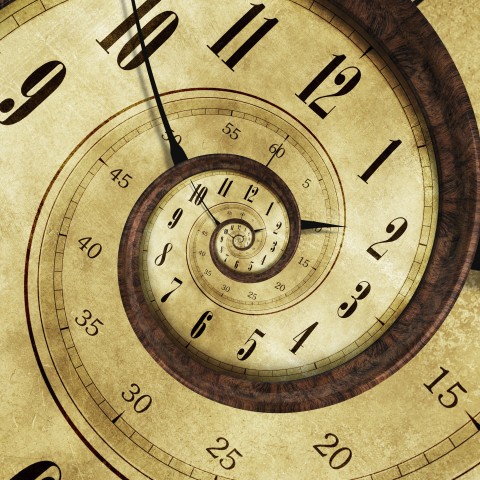
Ore e minuti (“Hours and minutes”)
4. How to Divide Hours into Minutes in Italian
When the digital watches came around, a lot of people started telling time like robots:
- Che ore sono? (“What time is it?”)
- Sono le 17 e 27. (“It’s 17: 27.”)
But luckily, people soon realized it was too ugly and stopped doing that. The normal behavior now is to round up the minutes to halves, quarters, and fives. Much better!
- mezz’ora (“half an hour”)
Notice how in front of ora, the word mezza drops the last letter, a, and adds an apostrophe (‘), becoming mezz’ora. But whenever you need to put it after the hour, to mean “half past…” then you use the complete word, either mezzo or mezza.
- … e mezza/mezzo (“half past…”)
In this case, telling time in Italian is much simpler than in English. You just need to put together the hour and the half hour with the conjunction e. Notice how both mezzo and mezza are correct.
- un quarto d’ora (“a quarter of an hour”)
Notice how here, too, we drop a letter and add an apostrophe, so that un quarto di ora becomes much nicer to hear and pronounce: un quarto d’ora.
- … e un quarto (“a quarter past …”)
To add just a quarter of an hour, you also need to put the conjunction e + un (indefinite article).
- Just like in English, an easy way to tell time is by fractions of five minutes, as in:
- le … e cinque (“five past …” or “… oh five”)
- le … e dieci (“ten past …” or “… ten”)
- le … e quindici (“fifteen past …” or “… fifteen”)
le … e venti (“twenty past …” or “… twenty”)
- le … e venticinque (“twenty-five past …” or “… twenty-five”)
- le … e trenta (“thirty past …” or “… thirty”)
- le … e trentacinque (“thirty-five past …” or “… thirty-five”)
- le … e quaranta (“forty past …” or “… forty”)
- le … e quarantacinque (“forty-five past …” or “… forty-five”)
- le … e cinquanta (“fifty past …” or “… fifty”)
- le … e cinquantacinque (“fifty-five past …” or “… fifty-five”)
- meno…
After half past thirty-five, normally in Italian you start saying the following hour “minus” the minutes needed to get to the top of the hour. For example:
- 10:40 = le undici meno venti (literally “eleven minus twenty”)
- 11:45 = le dodici/mezzogiorno meno un quarto (“twelve/noon minus a quarter”)
- 15:50 = le quattro meno dieci (“four minus ten”)
- 19:55 = le otto meno cinque (“eight minus five”)
5. General Time References of the Day in Italian
Telling the exact time, or being able to read a clock, is important. But since prehistoric times, people have talked about time by referring to the different stages of the day. So, if you want to have a more natural Italian conversation, here are the most common ways to give the general time of day in Italian.
Let’s remember that AM / PM isn’t commonly used in Italian. Instead, to avoid ambiguity or confusion, you’ll hear people mention di mattina, del pomeriggio, di sera, and di notte (“in the morning, in the afternoon, in the evening, at night”) after the time. These are the four basic stages of the day, but below is a more complete list of phrases using all the different parts of the day.

Dall’alba al tramonto (“from dawn to dusk”)
| Sono uscita di mattina presto. | “I left early in the morning.“ |
| Faccio colazione a metà mattinata. | “I have breakfast mid-morning.” |
| Mi sveglio sempre all’alba. | “I always wake up at dawn.” |
| Ci vediamo a mezzogiorno (ad ora di pranzo). | “See you at noon (at lunchtime).” |
| Ti chiamo nel primo pomeriggio. | “I’ll call you in the early afternoon.” |
| La festa comincia nel tardo pomeriggio. | “The party starts in the late afternoon.” |
| Com’è bella la montagna al tramonto! | “How beautiful the mountain is at sunset!“ |
| Non esco mai di sera tardi. | “I never go out late at night.” |
| È ora di cena. | “It’s dinner time.” |
| Non si può fare rumore a notte fonda. | “No noise can be made in the middle of the night.“ |
| Ho sentito un rumore nel cuore della notte. | “I heard a noise in the dead of night.“ |
| È tardi: ora di dormire! | “It’s late: time for bed (nap time)!” |
6. Top Italian Time Adverbs

Once you’ve mastered how to say the time, how to talk about all the stages of the day and night, you still need some other little words that help you indicate when something happens. When talking about time in Italian, these adverbs of time will be immensely helpful:
- adesso/ora (“now”)
Il treno parte ora. (“The train leaves now.”)
- al momento (“at the moment”)
Al momento non abbiamo tavoli liberi. (“At the moment, we don’t have free tables.”)
- nel frattempo (“in the meantime”)
Nel frattempo preparo il pranzo. (“In the meantime, I’ll prepare lunch.”)
- prima/dopo (“before/after”)
Ci vediamo prima di cena o dopo cena? (“Shall we meet before dinner or after dinner?”)
- presto/tardi (“early/late”)
Per favore, arriva presto. Non fare tardi come al solito. (“Please, be there early. Don’t you be late as usual.”)
- tra un po’ (“In a while”)
Pay attention to the apostrophe (‘). It’s there to indicate that it was originally a longer word (poco) that dropped the last syllable.
Ora non ho voglia. Lo faccio tra un po’. (“Now I don’t want to. I’ll do it in a while.”)
- per molto/poco tempo (“for a long/short time”)
Per molto tempo ho creduto a Babbo Natale. (“For a long time, I believed in Santa Claus.”)
- sempre/mai (“always/never”)
- Vai sempre in palestra? (“Do you always go to the gym?”)
- No, non ci vado mai. (“No, I never go.”)
- il prima possibile (“as soon as possible”)
Ho bisogno della relazione il prima possibile. (“I need the report as soon as possible.”)
- in qualsiasi momento (“at any time”)
Può succedere in qualsiasi momento. (“It can happen at any time.”)
- di tanto in tanto (“from time to time”)
È bene fare una pausa di tanto in tanto. (“From time to time, it’s good to take a break.”)
7. Italian Proverbs and Sayings about Time
Time is such a universal and primordial concept that in all cultures, you’ll find many proverbs and sayings about it. Here are some of the most common proverbs and sayings about time in Italian.
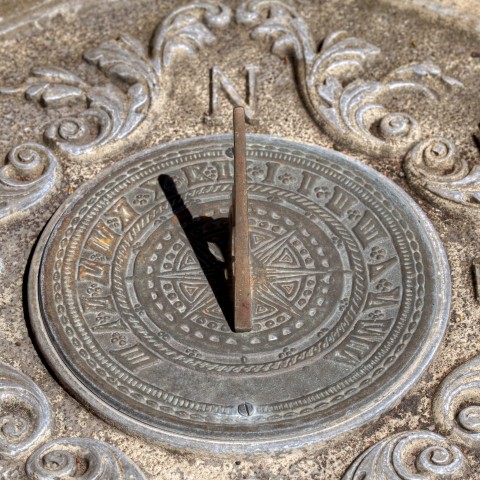
| Il tempo è denaro. | “Time is money.” |
| Il tempo vola. | “Time flies.” |
| Chi ha tempo non aspetti tempo. | “Those who have time do not wait for time.” Meaning: Basically, it’s an invitation to act immediately without hesitation. |
| La notte porta consiglio. | “The night brings counsel.” Meaning: The best decisions must be made with a clear mind, better if after a long sleep. |
| Dare tempo al tempo. | “Give time to time.” Meaning: Allow things to fall into place by waiting for the right moment. |
| Il tempo è galantuomo. | “Time is a gentleman.” Meaning: Time restores the truth, repairs all wrongs, and heals everything. Therefore, we must learn to wait. |
| Ora di punta. | “Rush hour.” Meaning: This literally means “peak hour” because it refers to a peak in a diagram. |
| Fare le ore piccole. | Literally “to make the small hours.” Meaning: It means to stay up or out until very late (one, two, or three). |
| Non vedo l’ora (che succeda…). | “I can’t wait (for something to happen).” |
8. Conclusion

I bet time flew while learning to tell time in Italian and more. Now you can practice telling time: make plans with your Italian friends, ask strangers for the time, or find out what time the movie starts.
But most importantly, don’t stop now! Go on and keep learning Italian with fun lessons and tons of podcasts and videos on ItalianPod101.com. We’ll help you improve quickly.
Before you go, practice telling time in Italian by dropping us a comment with the current time in Italian! We look forward to hearing from you!

Directions in Italian: Learn “Right” in Italian & More!

Are you traveling through Italy? Do you need to get to the Colosseum? Are you taking art classes in Florence?
If you’re in Italy and you want to enjoy getting around and exploring new places, get ready to ask for directions in Italian with this quick and easy guide. No need for maps or GPS if you can get a little help from locals and practice your Italian in the process.
In this article, I’ll be going over direction phrases in Italian, and will teach you words like “right” in Italian and much more!

Table of Contents
- On the Map: Cardinal Directions in Italian
- On the Road: Street Directions in Italian
- Directions in Italian Using Landmarks
- Italian Phrases for Asking (Politely) for Directions
- Must-know Italian Phrases for Giving Directions
- If You Get Lost
- Streets, Squares, and More (Much More!)
- Conclusion
1. On the Map: Cardinal Directions in Italian
Whether you’re old-school and like to rely on paper maps, or you’re more into new gadgets and like to get around with GPS apps, one of the first things to learn is how to ask for compass directions in Italian when planning your trip on a map.
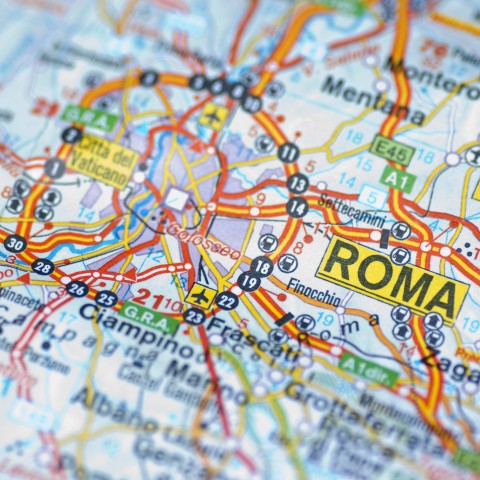 Tutte le strade portano a Roma. (“All roads lead to Rome.”)
Tutte le strade portano a Roma. (“All roads lead to Rome.”)
- Nord — “North”
- Sud — “South”
- Est — “East”
- Ovest — “West”
These (and their combinations nord-est, sud-ovest, etc.) are the essential words you need to learn to find your way around a map of the country. Other than that, Italians don’t have the habit of referring to cardinal points when giving directions, and they’re mainly used to indicating the parts and areas of Italy.
When talking about directions in English, it’s very common to say things like “go north on Second Street” (prosegui a nord su Second Street). Instead, Italians almost never use directions when giving directions. Italians mostly mention the directions when describing geographical features.
-
– Milano è nel nord d’Italia.
“Milan is in the north of Italy.”
– Napoli e Palermo sono le maggiori città del sud d’Italia.
“Naples and Palermo are the major cities in the south of Italy.”
– Pompei si trova a sud di Napoli.
“Pompeii is located south of Naples.”
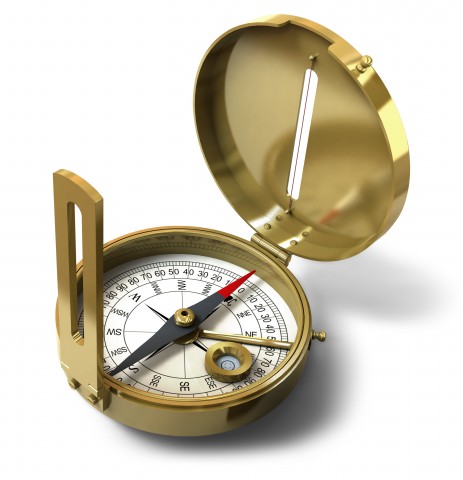 Hai perso la bussola? (Literally, “Did you lose your compass?” meaning also “Are you lost? Out of your mind?”)
Hai perso la bussola? (Literally, “Did you lose your compass?” meaning also “Are you lost? Out of your mind?”)
In Italy, you’ll never hear someone talking about the north part of the city. Instead, almost every city can be divided into il centro storico, or “the historical center,” historically the old part of town, and la periferia or “the outskirts”/”the suburbs,” which are the newer parts of the town.
2. On the Road: Street Directions in Italian

For road directions in Italian, you’ll need a series of relative indicators that will help you easily find where to go. Here are the most important ones:
| a destra; a sinistra | “to the right”; “to the left” |
| davanti; dietro | “in front”; “behind” |
| vicino; lontano | “near”; “far” |
| accanto a | “next to” |
| all’angolo; dietro l’angolo | “at the corner”; “around the corner” |
| da questo lato; dall’altro lato | “on this side”; “on the other side” |
| a [due minuti] di distanza | “it’s [two minutes] away” |
Notice to say “right” in Italian we say destra, but just in the sense of left and right. If you mean “right” as in “correct,” you’ll have to say giusto. Giusto?
-
A: È vicino il Duomo?
“Is the Duomo near?”
B: Saranno 5 minuti a piedi.
“It’s probably a five-minute walk.”
B: Prendi la prima a sinistra, poi la seconda a destra. Il Duomo è dietro l’angolo.
“You turn left at the first intersection, then turn right at the second intersection. The Duomo is around the corner.”
3. Directions in Italian Using Landmarks
When you’re traveling, there are so many landmarks that you’ll go to or pass by. So it’s important to know the names of the main public buildings and of all the places of tourist interest in a particular city. When asking for directions, make sure you know the following words and phrases:








